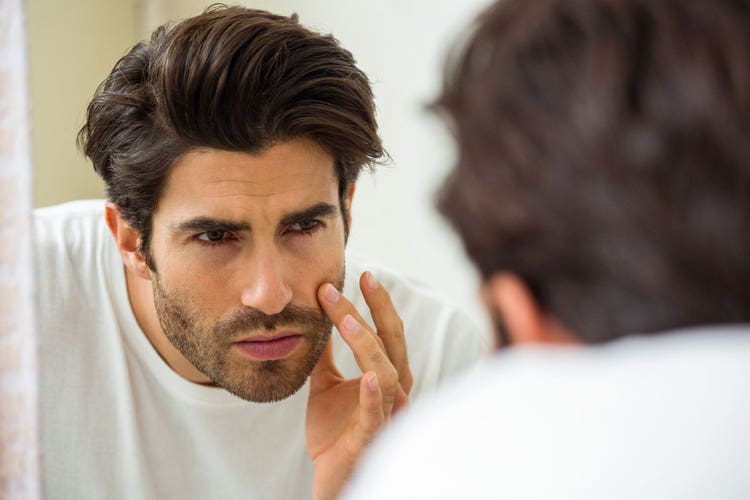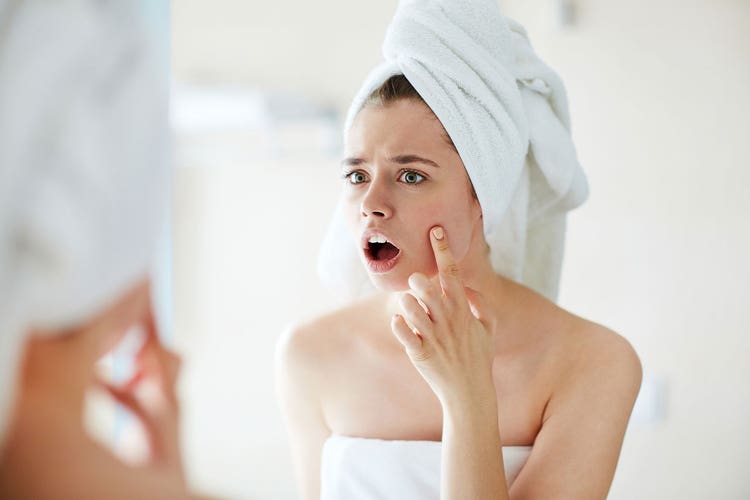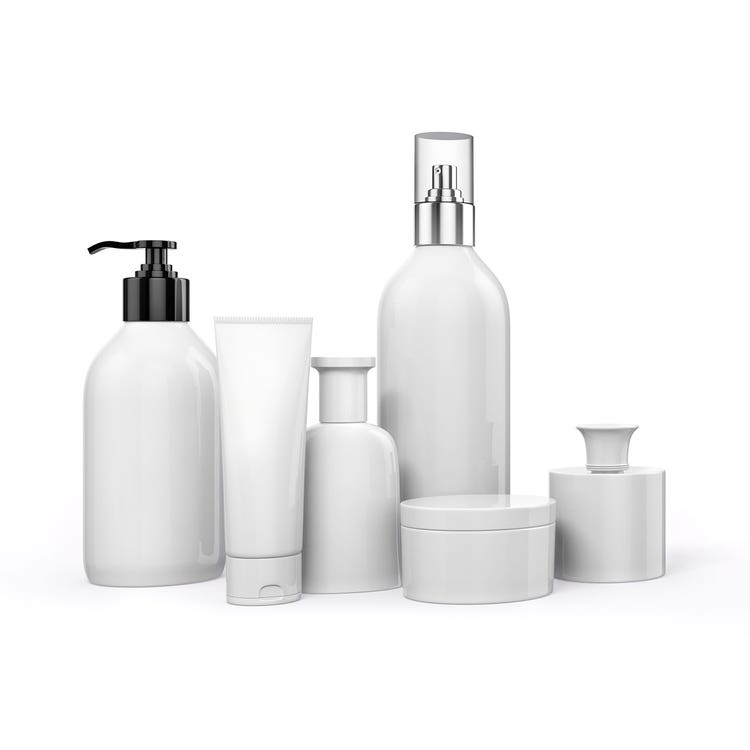Seeing Spots

Eight reasons why you might have adult acne and how to get rid of it.
It’s safe to say that you probably left your locker and Trapper Keep behind in high school. There’s one more thing you’d like to leave in the past, but it might be popping up now. We’re talking acne. And it’s not uncommon for people who didn’t experience it as teens to get it for the first time in their 20s, 30s, 40s and beyond.
“Adult acne is getting more common in both men and women,” says Jeanine B. Downie, M.D., director of Image Dermatology in Montclair, New Jersey. It should be treated differently than the teen variety because many products designed for adolescents are too tough on mature skin. “Acne can be one of the most difficult conditions to treat because there are so many varying causes,” says Marc Ronert, M.D., president and clinical director of Image Skincare. “The best way to control acne is to start with a healthy balanced skin-care regimen. Balance the skin before the condition gets out of control.”
Typically, all acne, whether adult or adolescent, is primarily caused by three events. “The first is clogging of pores with sebum, dead skin cells and debris, causing blackheads and whiteheads,” says Ted Lain, M.D., Proactiv partner dermatologist. “This plug leads to the second event, a proliferation of bacteria within the pore. Inflammation, the third event, ensues because of this bacteria, as the immune system is activated to start fighting this infection, leading to the formation of red acne blemishes.” Excessive production of sebum, our skin’s natural oil made by glands that reside within the pore, can make acne worse. Genes and hormonal factors play a role in overactive oil glands, and dermatologists can prescribe medications to help.
Wondering what’s causing your breakouts? These are the eight most common reasons and what you can do about them.
Lifestyle
Stress is one of the biggest factors in adult acne. “People don’t realize how stress can lead to the buildup of toxins in the body, thus leading to changes in the skin,” Ronert explains. Diet also can impact your skin. Occasionally, dairy and soy may flare adult acne, and sometimes foods that contain GMOs and other additives can, as well.
Hormones
While both men and women experience adult acne, gender can affect it. “Adult acne usually occurs when there is a fluctuation in the hormones,” Ronert says. “For men, it would be the loss of testosterone. For women, it occurs during perimenopause when estrogen begins to degenerate. Acne triggered by hormones can be the most difficult to treat.” But when it comes to breakouts, it’s not significantly different. “Both men and women can get comedones, papules, pustules and cysts,” Downie says. “Many women get hormonal acne around their jaw line—this would be the only difference.”
Skin-care regimen
“Consistent appropriate skin care is the best way to prevent breakouts,” Lain says. “The adapalene in the ProactivMD system (from $20, proactiv.com), combined with the cleanser, toner, moisturizer and sunscreen that were all formulated specifically to be used with adapalene, can be used in any skin type and is an excellent first step to help control breakouts.” Adapting a skin-care regimen is easier than you think. A crucial step is washing your face regularly; most people should do so twice a day. “The best technique is to wet the face with warm water, then apply the cleanser using fingertips and a circular motion for 30 to 60 seconds,” Lain advises. “I always caution to not use too much pressure when cleansing, especially if the cleanser contains particles, in order to make sure that the skin is not abraded.”
Look for a cleanser with acne-fighting ingredients, such as alpha hydroxy acids (glycolic or lactic acid) or beta hydroxy acid, aka salicylic acid. “These ingredients help to gently exfoliate, thus removing the dead skin cells and debris and possibly reducing the likelihood of blackhead and whitehead formation,” Lain says. “Salicylic acid tends to penetrate deeper into the pore, causing exfoliation at a level unattainable with the alpha hydroxy acids.”
As far as a moisturizer, make sure the label includes “non-comedogenic,” meaning that the moisturizer is tested to not increase the formation of blackheads and whiteheads; try Image Skincare Mattifying Moisturizer ($26, imageskincare.com). After that, the type of moisturizer depends on the individual skin type and other products in the regimen. Those with oily skin would want to focus on lotions, which are water-based and lighter, while those with sensitive or dryer skin may want creams, which are oil-based and thicker. Never go to bed with makeup on, and if you have active acne, changing your pillow cases a couple of times a week is also very helpful.
Picking at your skin
Popping a zit can be tempting, but that will actually create a bigger problem. “People should not pick at their acne because that just makes it worse and can scar your face,” Downie says. “Not picking at your acne can help heal a breakout as it may heal faster.” Instead, use a spot treatment to target pimples. Downie recommends using the Neutrogena Light Therapy Acne Spot Treatment ($20, target.com) to zap trouble spots. Be sure the acne products have anti-inflammatory ingredients to reduce redness and post-inflammatory hyperpigmentation that can occur as skin begins to heal, and apply a spot treatment only once or twice a day to avoid drying out the area surrounding the blemish.

Bacteria
“Bacteria-rich acne is a relatively slow-growing type of acne,” Ronert says. “It is usually a long-lived condition and can eventually lead to deep acne scarring.” Think you’re not exposed to bacteria? The main culprit is shockingly common: your cellphone. When you talk on your cell, the bacteria transfers to your face. Wipe your screen down regularly to prevent this.
Skipping sunscreen
“Any patient with acne should wear sunscreen every day, rain or shine, January through December, regardless of their racial ethnicity,” Downie says. “This is because if you have a pimple and you don’t put on sunblock every day, you will have a dark spot or a pink spot left behind when the acne fades. I recommend oil-free products. I love Neutrogena and Aveeno facial sunblock products with an SPF of 30 or more.”
Pollution
Yep, environmental causes can sometimes be to blame. “Air pollution, including smog, chemicals and toxins, can clog your pores and cause an acne flare,” Ronert says. This is yet another reason washing your face is important, particularly before bedtime, to remove toxins and pollution.
Over-treatment
When it comes to dealing with acne, less can be more. “Many people use too many products and over-treat their acne, leading to excessive dryness, redness and irritation,” Lain says. “Mild dryness and scaling at the initial stages of a new regimen are completely normal, but these should resolve after two to three weeks and the skin should remain free of these thereafter.” Other common mistakes include using products that aren’t oil-free and non-comedogenic. Hypoallergenic and fragrance-free products are best for acne-prone skin. “I would also avoid over-scrubbing the skin with abrasive products; this can sometimes lead to more oil production and inflammation,” Ronert says.

Photo credits: WavebreakmediaMicro Adobe Stock; DragonImages, Thinkstock; DGLimages, Thinkstock; shironosov, Thinkstock; digitalgenetics, Thinkstock